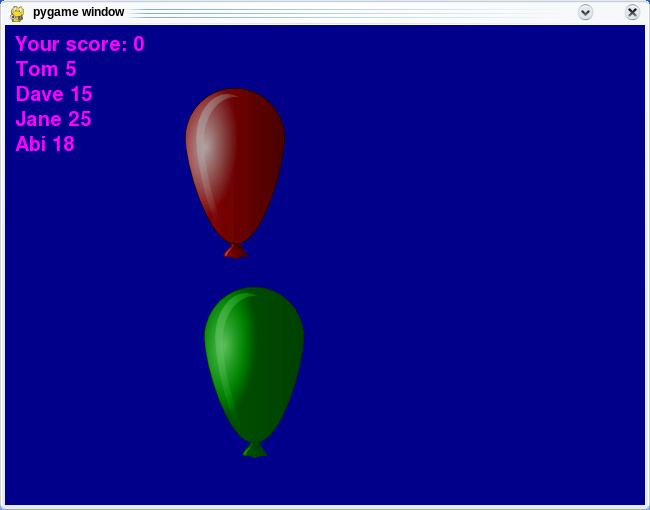
In a separate file (not a pygame program to make it easier to debug), write a function to read in and process the file. This function should take string parameter, which is the name of the file to be read. It should return a list of lists, where each of the inner lists has length 2 and just consists of a person's name and his/her score.
For example, when reading in the file give above, this function should return the following list:
[['Tom', 5], ['Dave', 15], ['Jane', 25], ['Abi', 18]]Note that the names are strings and the scores are integers.
Add the first function you wrote (the one that reads in the high scores from a file and returns a list) to your program. Call this function before the game loop starts and assign the return value (i.e., the list of player name-score pairs) to a name.
Now, draw all of the high scores on the screen in addition to the line that shows the current score. So, your window should look something like this when you are done:

In a separate file (not a pygame program to make it easier to debug), write a function that takes a list of the format produced by the previous step as parameter and returns that index of the entry with the lowest score.
For example, when given the list
[['Tom', 5], ['Dave', 15], ['Jane', 25], ['Abi', 18]]the function should return 0, because that is the index of the entry ['Tom', 5], which has the lowest score.
When when given the list
[['Dave', 15], ['Jane', 25], ['Tom', 5], ['Abi', 18]]the function should return 2.
Now add the second function you wrote (the one that finds the index of the smallest score) to your program.
If the player clicks next to the balloon and dies, update the list of high scores if necessary.
That means, if the player misses the balloon (that condition is already there in the part of the code that handles events), check whether the list of high scores is shorter than five elements. If so, add a new element which has the name of the current player and his current score. If the list of high scores is longer than five or of length exactly five, find the index of the smallest score in the list. If that player's current score is greater than that score, replace that entry with a new entry that has the name and score of the current player.
For example, if the list of high scores is
[['Dave', 15], ['Jane', 25], ['Tom', 5], ['Abi', 18]]when the current player dies (i.e., the length of the list is four), add that player's name and score to the list:
[['Dave', 15], ['Jane', 25], ['Tom', 5], ['Abi', 18], ['Kay', 6]]If the list of high scores is
[['Dave', 15], ['Jane', 25], ['Tom', 5], ['Abi', 18], ['Kay', 6]]]when the current player ('Kate') dies and the current player's score is 3, the list doesn't change because the smallest score in the list is greater than the current player's score. However, if the current player's score is 7, the list gets updated to
[['Dave', 15], ['Jane', 25], ['Kate', 7], ['Abi', 18], ['Kay', 6]]]That is, the entry with the lowest score gets replaced with the current player's information.
Finally, after updating the list of high scores, write the list back to the file.
For this, write a function that takes a string (the file name) and a list of name-score pairs as parameters and writes one line to the file for each pair. The format of the file should be like the original format of the high scores file.
For example, if the list of high scores is
[['Dave', 15], ['Jane', 25], ['Kate', 7], ['Abi', 18], ['Kay', 6]]]the resulting file should look like this:
Dave:15 Jane:25 Kate:7 Abi:18 Kay:6